Though often packed and noisy on the weekend, Wulai (
1. Wulai Bus(just down the road from the Hsintien MRT station)
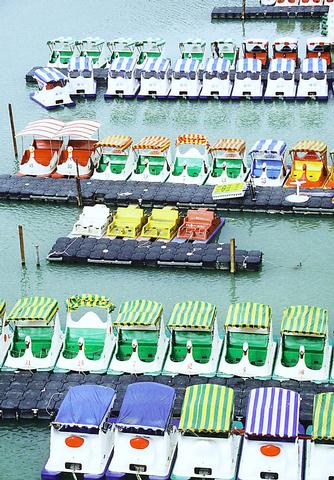
PHOTO: JULES QUARTLY
If you don't have your own transportation or prefer not to drive the mountain roads to Wulai, take the MRT to Hsintien (新店), the southern terminus of the Hsintien-Tamsui line, and catch this handy bus just outside the station for the half-hour trip. Driving is ill-advised on weekends because of heavy traffic.
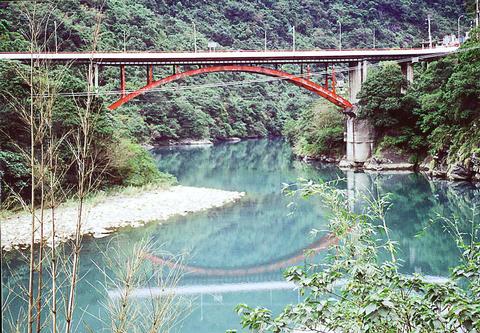
PHOTO: JULES QUARTLY
2. Pitan Bridge (碧潭橋), Hsintien
On your way to Wulai, take time to stop off at Pitan Bridge. Looking south, this gracefully swaying suspension bridge offers views of the hills that lead to Wulai. Beneath is the jade green Nanshih River (南勢溪) and on weekends it is dotted with hundreds of pedaloes. On the far side of the bridge is a covered food market, and on the near side rows of teahouses, food stalls and small restaurants. There is plenty to do for the whole family. Pedaloes cost NT$300 per hour to rent; rowboats and canoes are similarly priced.
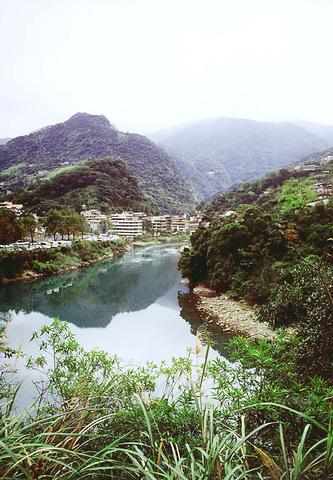
PHOTO: JULES QUARTLY
3. Bi-ting Tea House (碧亭)

PHOTO: JULES QUARTLY
The main draw here is the view and general ambience of the teahouse, which is perched on a ledge half way up a cliff overlooking the Nanshih River and the city of Hsintien. This is an ideal place to spend a relaxing afternoon and talk over a pot of tea. Tea is NT$200 a pot and a selection of dried or salted sundries such as mango, prunes, nuts, pistachios or chickpeas is also available. Open 10am until around 2am on weekends, it closes earlier during weekdays. 1 Pitan Rd., Hsintien (新店市碧潭路1號), tel: (02) 2212 9467
4. Picnics and fishing
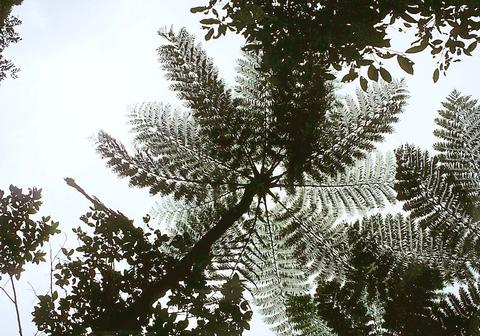
PHOTO: JULES QUARTLY
On the way to Wulai are plenty of points where you can settle down for a barbecue or picnic while enjoying the river and nearby trails. There are also many convenient fishing holes where anglers pit their wits against the 30 species of fish in the river. If the fish aren't biting, the fire fails to light and the picnic is a washout there are plenty of roadside restaurants.
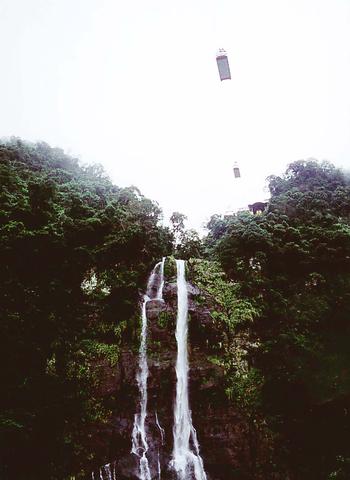
PHOTO: JULES QUARTLY
5. Yung Feng Art Sculpture (永峰藝術)
There are many small woodwork factories and shops in and around Wulai, but this is probably the best. You will likely be given a cup of hot ginger tea by proprietor Shau Chang-cheng (邵張承) as you take a stroll around the shop, which is packed with images of deities, animals and elaborate tea tables. You can even have items made to order. The best pieces are carved from a single piece of wood, where the form of the wood dictates the design. Prices range from NT$100 to NT$40,000. 48-2 Yanti Rd., Wulai Township, Taipei County (台北縣烏來鄉堰堤路48-2號), tel: (02) 2661-7007
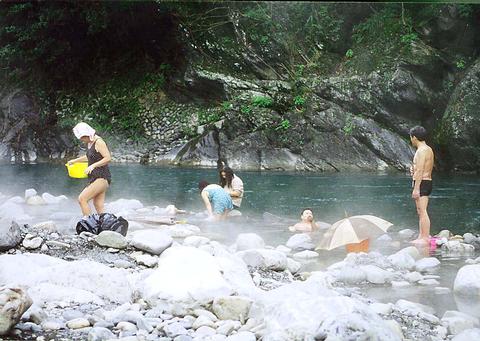
PHOTO: JULES QUARTLY
6. Monaludo (莫那魯道)

PHOTO: JULES QUARTLY
Taiwan's own Robin Hood, Monaludo was a leader of the Atayal Aboriginal tribe who led a rebellion against the Japanese during the colonial period. The Japanese in retaliation put a price on his head and eventually caught and killed him. His body was later taken to a museum in Japan and was only recently returned to Taiwan for burial. This combination motel, bar, diner and jazz venue has appropriated the name of Monaludo if not the Robin Hood spirit. It offers 12 rooms with en suite hot tubs that can be rented by the hour to cater to couples, families and parties. Choose a movie, fill the tub, get your clothes off and enjoy. (See restaurant review).
7. Green Hill Hotel (碧山閣飯店)
Wulai's first hotel, the Green Hill Hotel was founded 60 years ago when the best views were of hills filled with the haze of blue smoke from homestead fires. The views of the river and hills are blocked now because of more recent developments. You can get a quaint room for between NT$1,500 and NT$8,000. 79 Wulai St., Wulai Township (台北縣烏來鄉烏來村烏來街79號), tel: (02) 2661-6342, 2661-6114
8. Main street vendors
All along the main drag are a variety of stalls and small shops selling local produce like plates of river shrimp and fried fish, along with Aboriginal specialties such as iced white fungus (白木耳), which has an otherworldly look but tastes quite good. There is also shrimp wine (蝦酒), an alcoholic Aborigine tonic, in addition to a wide range of other wines and spirits made from cereals, roots and even bee pupae. Bamboo rice (竹筒飯), made from mushrooms, shrimp and rice, cooked in a section of bamboo, is a tasty snack that can be bought from stalls all along the strip. A word of warning -- this is a tourist trap and visitors risk being overcharged by some vendors.
9. Shanchen Restaurant (山珍飯店)
Shanchen was one of the first restaurants to open in Wulai; it also has a story to it, one that could have come straight out of Hollywood. It is presided over by 97-year-old Liao Huang-jin (廖黃金), known to everyone simply as Amah. Her story can be summarized as such: A backwater town, hard times, Liao starts a small eatery, not many customers, invents a soup, everybody loves it, people flock from miles around, massive success, credits roll. Fifty-five years later, Amah is still at it, and at 97 is still around to keep an eye on the staff and customers and help with the serving. (See restaurant review)
10. Hsiao Chuan Yuan Hot Spring (小川源溫泉)
Run by hot spring enthusiast Hong Rong-chuan (洪榮川), who went to Japan to learn how to do it right, the charismatic owner has developed a hot spring unlike any other in the area. At Hsiao Chuan Yuan, the water temperature is regulated by computer and a wide variety of water massages are offered. Hong has become quite a celebrity and insists that a hot spring bath each day keeps aging and the doctor at bay. Hsiao Chuan Yuan is also cheaper than many other establishments, charging only NT$250 for up to four hours of complete relaxation. 32 Wulai St., Wulai Township, Taipei County (台北縣烏來鄉烏來街32號), tel: (02) 2661-6222
11. Toll bridge
A bit like the three billy goats gruff, you have to pay to get over to the other side of the river, where the grass is greener, the scenery better and the trails longer. The tariff is NT$50 and is definitely worth the price.
12. Free bathing
After crossing the toll bridge from the town of Wulai, there are free bathing areas both upstream and downstream. The only disadvantages are the lack of changing facilities for the modest and the absence of toilets. Otherwise, enjoy the mountain views, party atmosphere and piping-hot spring water. Take a dip in the river to cool down. Hot spring action as nature intended.
13. Mini Railway (烏來觀光台車)
Originally the railway was built for the logging industry that once operated in Wulai. That was a long time before tourists discovered its charms. Now, refurbished cars offer a five minute ride for NT$50.
14. Cable car
For a rather expensive NT$220 return ticket, you get a spectacular journey over the river valley to the aptly named Cloud Fairy Hotel (雲仙飯店), where rooms are a whopping NT$16,000 a night. Dreamland (雲仙樂園), located at the end of the cable car ride, is an Aboriginal theme park which offers a wide range of recreation and leisure facilities. (1-1 Pubu Rd., Wulai Township, Taipei County; 台北縣烏來鄉烏來村瀑布路1-1號, tel: (02)2661-6510-3.) Catch the cable car from the station near the Chu Lung Recreation Resort (巨龍渡假村) located at 85 Yanti Rd., Wulai Township (台北縣烏來鄉堰堤路85號), tel: (02) 2661-6333
15. Doll Valley (娃娃谷)
No permits are required, but do take your passport, as the police will check your visa because of a military base in the vicinity. It is a 5km walk from Wulai to Doll Valley. There is also a bus service from the Wulai bus station to Doll Valley leaving at 5am, 12.30pm and 5.30pm daily. There are some great trails, cycle paths, a small waterfall, an old dam, a little reservoir and a Forest Park. The park is good for bird watching and home to foxes, flying squirrels, deer, wild pigs and the occasional black bear.

May 26 to June 1 When the Qing Dynasty first took control over many parts of Taiwan in 1684, it roughly continued the Kingdom of Tungning’s administrative borders (see below), setting up one prefecture and three counties. The actual area of control covered today’s Chiayi, Tainan and Kaohsiung. The administrative center was in Taiwan Prefecture, in today’s Tainan. But as Han settlement expanded and due to rebellions and other international incidents, the administrative units became more complex. By the time Taiwan became a province of the Qing in 1887, there were three prefectures, eleven counties, three subprefectures and one directly-administered prefecture, with

Taiwan Power Co (Taipower, 台電) and the New Taipei City Government in May last year agreed to allow the activation of a spent fuel storage facility for the Jinshan Nuclear Power Plant in Shihmen District (石門). The deal ended eleven years of legal wrangling. According to the Taipower announcement, the city government engaged in repeated delays, failing to approve water and soil conservation plans. Taipower said at the time that plans for another dry storage facility for the Guosheng Nuclear Power Plant in New Taipei City’s Wanli District (萬里) remained stuck in legal limbo. Later that year an agreement was reached

What does the Taiwan People’s Party (TPP) in the Huang Kuo-chang (黃國昌) era stand for? What sets it apart from their allies, the Chinese Nationalist Party (KMT)? With some shifts in tone and emphasis, the KMT’s stances have not changed significantly since the late 2000s and the era of former president Ma Ying-jeou (馬英九). The Democratic Progressive Party’s (DPP) current platform formed in the mid-2010s under the guidance of Tsai Ing-wen (蔡英文), and current President William Lai (賴清德) campaigned on continuity. Though their ideological stances may be a bit stale, they have the advantage of being broadly understood by the voters.

In a high-rise office building in Taipei’s government district, the primary agency for maintaining links to Thailand’s 108 Yunnan villages — which are home to a population of around 200,000 descendants of the Chinese Nationalist Party (KMT) armies stranded in Thailand following the Chinese Civil War — is the Overseas Community Affairs Council (OCAC). Established in China in 1926, the OCAC was born of a mandate to support Chinese education, culture and economic development in far flung Chinese diaspora communities, which, especially in southeast Asia, had underwritten the military insurgencies against the Qing Dynasty that led to the founding of